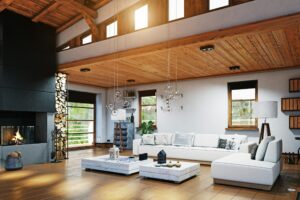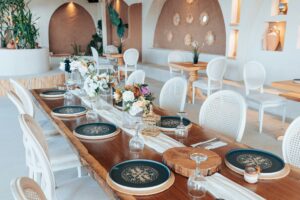
Have you ever walked into someone’s home and immediately felt overwhelmed? Let’s face it: we all can get addicted to stuff. But some environments push it to the limit. Walls crammed with books. Shelves of photos and knick-knacks and travel mementos. Single-item collections that continue to expand (e.g., multiple glass cases full of ceramic cow creamers). Even beautiful artwork and cultural objects that can dominate a space.
While some folks are genuine pack rats who can’t seem to throw anything out, most people struggle with “what to display and what to put away.” Minimalism might seem the easiest path to pursue.
Striving Toward Simplicity
The desire to unclutter an environment, as exemplified by organizing gurus like Marie Kondo, might be motivation enough to embrace the “ease” of minimalism. But the truth is that, like any other interior design style, minimalism requires a strategic approach. Done correctly, it dispels the stereotype of being cold and uninviting, instead creating a comfortable and personal space.
Minimalism is more than just an aesthetic choice. It’s a philosophy that embraces simplicity, functionality and the idea that every element in a space serves a purpose. Rooted in the art movement of the 1960s, which rejected excess in favor of purity and clarity, minimalist interior design follows the same principles by emphasizing clean lines, open space and a restrained color palette to create environments that feel airy, uncluttered and intentional.
Neutral and Two-Tone Color Schemes
Minimalist spaces often rely on neutral color palettes to establish a sense of calm and openness. White, beige, soft gray and muted earth tones foster serenity and allow architectural elements and furniture to stand out. Two-tone schemes, such as black-and-white or warm wood against a light backdrop, offer subtle contrast while still maintaining simplicity. These palettes enhance the uplifting effect of negative space, making rooms feel larger, brighter and more tranquil.
Emphasis on Natural Materials and Textures
A hallmark of minimalist design is the use of natural materials like wood, stone and glass. These deliver texture and warmth, preventing spaces from feeling sterile. Unfinished wood, marble or granite countertops, slate tiles and woven textiles add depth and contrast to a clean aesthetic without overwhelming the senses. By incorporating organic elements, minimalist interiors can help forge a connection with nature, nurturing a feeling of balance and grounding.
Functional and Uncluttered Furniture
Minimalist furniture is simple, sleek and purposeful. Straight lines, common geometric shapes and unadorned surfaces define the style. Multi-functional pieces, such as a storage ottoman or a dining table with hidden drawers, help maintain order without sacrificing convenience. Rather than crowding a room with furnishings, minimalist interiors focus on a few high-quality, well-chosen pieces that contribute to the overall aesthetic.
Intentional Décor and Accessories
Minimalism doesn’t mean the absence of personality – it means intentional choices. Décor is kept to a minimum, with a focus on quality and placement. A single statement artwork, a well-positioned sculpture or a curated collection of books can serve as focal points. Houseplants are also popular in minimalist design, adding natural touches of greenery in strategic spots.
Lighting: Enhancing Openness and Tranquility
Lighting plays a crucial role in minimalist design. The priority is on natural light through large windows and sheer curtains to maximize brightness. Artificial options lean toward recessed lighting, sleek pendant lamps and strategically placed floor lamps that provide illumination without visual clutter. The goal is to create a soft, ambient glow that enhances the sense of openness and calm.
Balancing Functionality Through Storage
One challenge of minimalism is functionality in everyday life, especially in areas like the kitchen. Is it practical to have nearly nothing on the counters – no toaster oven, coffee machine or utensil containers? While some high-use items may sit out, others can be stored in large opaque storage compartments and well-organized cabinets integrated into a kitchen design. Minimalism doesn’t mean eliminating convenience, rather finding innovative ways to achieve a practical balance.
All or Nothing?
Minimalism must be thought of as a design approach, not an inflexible rule. Embracing the value of minimalism doesn’t mean an all-or-nothing approach. Some people find joy in sparse, Zen-like spaces, while others look more toward functional comfort. The essence of minimalism is organization, tranquility and intentionality, whether that means completely decluttering or simply reducing excess to create a more calm, serene home. At the heart of it is personalizing a space that fulfills your needs. Find ideas at DRC Showrooms today.





Leave a Reply